
Tuesday, January 30, 2007
Chincicle
What do you get when you combine a 10-degree (f) ambient temperature, 15 mile-per-hour headwind, knit polyester balaclava and 45 minutes of huffing and puffing? Yes, it's the eminently lickable and delicious chincicle! Yum!


Friday, January 26, 2007
New Dummy Photos
The Surly folk have posted some pics of the next step in the Big Dummy's evolution:

From the Surly blog:
It's so hard to be patient.

From the Surly blog:
We’re getting closer to production. We’ve got a short list of small changes to make at this point. At least one more sample must be produced and approved before we can place the Big Dummy purchase order. This is pretty typical of the pre-production development process. There are generally too many variables (tube spec, geometry, braze-on placement, etc) to design it perfectly in one shot.I like the swoopy Instigatorish top tube.
It's so hard to be patient.
Thursday, January 25, 2007
Untapped Biofuel

For the fifth consecutive year, President Bush used the State of the Union address to outline some hazy strategy for developing alternatives to fossil energy. But once again, he neglected to mention the most powerful energy source of all. (click the pic.) (Thanks, Errol Morris)
Wednesday, January 24, 2007
Look Out Below

Okay kids, now remember, when you get to the bottom of the hill, stand up right away and look back to make sure nobody is about to run you over. And if you see that big furry kid in the Carhartt coming at you on his blaze orange sled, RUN FOR YOUR LIVES!
Monday, January 22, 2007
Batteries, schmatteries.

Last spring or so, I picked up a set of Reelights— LED blinkie lights for your bike that don't use batteries.
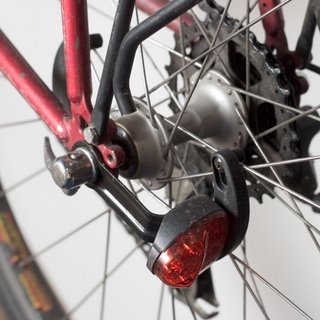
Reelights instead employ a pair of magnets that fasten to the spokes and Faraday's law of induction to create an open-air generator that makes the small amount of juice required to get the attention of your fellow road users. This is the same technology found in shaker flashlights and hand-cranked radios.

They're very simple. A metal bracket with a hole at one end mounts between the quick release nut or axle nut and the outside of the dropout. At the other end, about 3 inches away, a pair of LEDs are mounted in a sealed plastic enclosure. A pair of strong magnets in plastic brackets attach to the spokes. There is no on/off switch. Apart from the magnets being attached to the wheels, there are no moving parts at all.
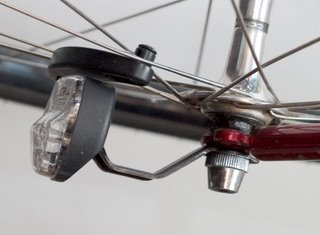
They're pretty easy to install. Attaching the bracket to the wheel is easy. Getting the two magnets attached to the spokes is a little trickier. The 28-spoke wheel on this particular bike required that the magnet brackets be turned at a bit of an angle (visible in the very first photo at the top of this post) but this has no perceptible effect on performance. Then the light is adjusted inboard or outboard on the bracket until it's within 1-3 mm of the magnets. You just have to make sure the magnets don't rub on the light.
Properly adjusted, you don't really even notice them. They just do their thing, day or night.

Here's the rear (sorry for the soft focus—I took these in the garage and I was starting to lose feeling in my fingers by the time I took this one.) Plenty of room yet for a fender stay, but not so compatible with larger panniers.

Here's one with the rear wheel spinning at about 40 rpm, frozen by the flash. The LEDs flash in sequence, each lighting once for each pass of the magnet. Only the left one is lit here. The net effect is a nice blink blink ... blink blink ... blink blink pattern, visible from quite some distance. The blinking varies in proportion to the speed of the bicycle. Their brightness comparable to most blinkies currently on the market, with the exception of the Planet Bike Superflash (dang, that thing is bright!).
Reviewed here are the SL-100 model. My wife used these all season on her '93 Bridgestone XO-4, and has been quite pleased with them. Why? No batteries! You don't have to buy them, store them, install them, worry about when they'll wear out, recharge them or send them to the landfill when they're dead. Sweet action. They're also ridiculously simple and seem impervious to foul weather. You don't have to think about turning them on or off—they just work.
There are two readily apparent drawbacks. The first is that they are constrained to a location near the axle, which might conflict with panniers or disk brakes. Second, the SL-100 version doesn't remain on when you stop. This might be fine if you're well-reflectored and using a headlight. It looks like Reelight has come out with a capacitor model that continues to blink for a while when stopped (the SL-120) but I'm not sure whether anyone has brought these to the US yet.
For another description, including where they're from, take a look at Hiawatha Cyclery's write-up. I bought both sets from them and have been quite satisfied with their mail-order service. Amazon carries them too, and more reviews are available there. Maybe someday we'll see them in regular bike shops...
Sunday, January 21, 2007
Xtrakoram
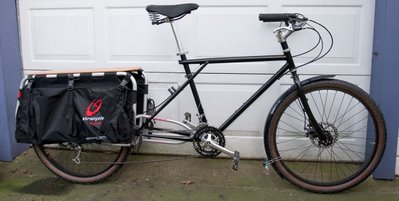
Our second Xtracycle has been up and running for a while, and it's high time I got around to profiling it. Most of the specs are outlined here, except that it's for sure a 1990 and not a '92. Todd chimed in about the geometry in the previous post's comments, but I'm pretty sure I'm describing it correctly. The '90 Karakorams were not made for front suspension, and the 1x1 fork is suspension-corrected. I think this ends up increasing the trail, and the end result is that I like the handling quite a bit. It still has a tendency to pull into corners a bit, but the steering seems quite a bit lighter than Marge's. Speaking of Large Marge, I've gotten a 1x1 fork and new headset installed, but I don't have the new disk brakes hooked up yet—so no ride report.
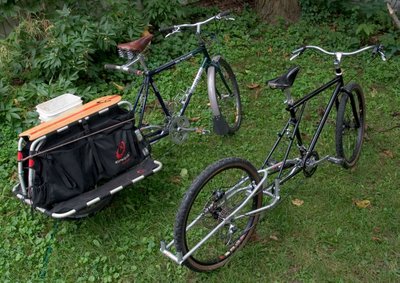
Here's a family picture. Marge will also soon be getting some spiffy new cruiser bars with lots of rise and a shorter stem with more rise.

Here's some goofy front brake cable routing. That's a Cane Creek Freestyle Assembly (it's got a hollow top-cap bolt) whose star nut was really fun to install without the proper tool. I had originally purchased it to conceal the wire from the dynamo to the headlight on Woody, but it somehow ended up here.

And just in case you've ever wondered what it would be like to put a rear fender on the front wheel, here it is (click for big). The lower part of the fender where it would have attached to the chainstay bridge was trimmed off with aircraft snips and cleaned up with emery cloth. The fork crown bracket was custom-cut and drilled, then fastened to the fender with Pop Rivets. And no, I wouldn't have set it up this way without those plastic fender stay QRs visible at the dropout. Does handily eliminate the need for a mudflap, but not too conducive to off-road riding.
I bought this frame knowing it was too small for me, hoping that a combination of its size and the GT triple triangle design would improve the overall torsional rigidity. I have to say, it does feel less rubbery than Marge and I really like its ride quality overall. My only complaint is that my knees occasionally come pretty close to, and sometimes hit, the ends of the Albartoss bars in low-speed turns.
Can't wait to see how it stacks up against a Big Dummy...
Saturday, January 20, 2007
Winter Returns
Here are a few pics from my Friday morning commute. Good to get the Moose out for a spin and put those studded tires to good use. Not a lot of cylists out this time of year—mostly the Hardpack Hardcorps.
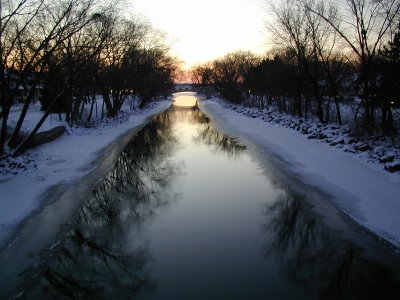
The Yahara River from the Jenifer Street bridge at sunrise.

Monona Terrace Convention Center parking ramp corkscrew.
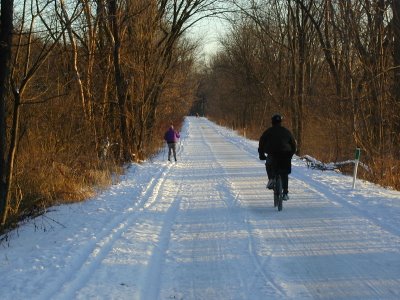
When we say "multi-use path," we really mean it.
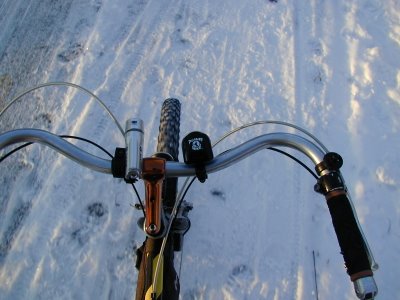
A view from the catbird seat.

The Yahara River from the Jenifer Street bridge at sunrise.

Monona Terrace Convention Center parking ramp corkscrew.

When we say "multi-use path," we really mean it.

A view from the catbird seat.
Thursday, January 18, 2007
Hang on a Sec


It's been seen here and here; and from another angle here, and gosh, folks love the stoker bar. Lets the little ones ride on the back of the Xtra without fear of falling off. Wished I'd have thought of it, but I must confess, I stole it from this design.
It's very simple to make an Xtracycle stoker bar. Mine is simply a sawed-off, cheapie mountain bike handlebar, a threadless mountain bike stem, a seatpost shim and a pair of grips.
The most difficult part would probably be finding a seatpost shim in the correct size, but most competent bike shops should be able to help. You'll need to know the inside diameter of the threadless stem—in my case, it's a 1-1/8 inch, which converts to 28.6 mm. Then, find the diameter of the seatpost (26.6 in my case) and subtract to find the difference. The part that won't compute at most shops is that there is, for example, no 28.6 to 26.6 shim. So I just looked at the catalog at the shop and found a shim close to those two diameters that had a difference of roughly 2.2 mm. These shims are slotted their entire length, they allow some expansion or contraction of their overall diameter to get the fit you'd need. For $8 and a couple of days of waiting, I ended up with a shim for 27.2 to 25.4—both very common sizes, but only 1.8 mm of difference. A seatpost-frame combination won't brook that much difference, but the threadless stem that I used easily drew .4 mm of extra tightening and has been very secure. I pick up the bike by the stoker bars as a matter of course, and the seatpost will shift in the frame before the stem will budge.
I sawed off the ends of the old mountain bike handlebars with a hacksaw, cleaned up the ends with a file, popped the grips on and put it all together. Sheer joy for the youngsters.

More views of the completed stoker bar
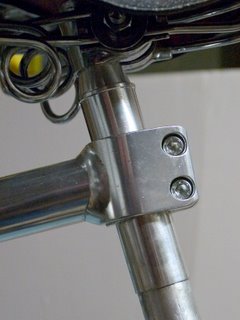
and a close-up of the shim.
Other variants can be seen here, here and here.
Monday, January 15, 2007
Swap 2007
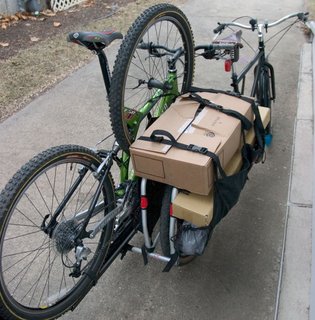
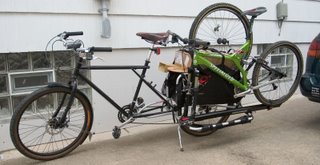
Yet another Madison bike swap has come and gone, and for the second year in a row I rode to the event with all my stuff. Yes, it's possible to haul the entire (if modest) contents of a swap table on an Xtracycle. On the left side is a dual-suspension mountain bike; on the right is a plastic bag containing 2 suspension forks and a rigid steel fork; in the cardboard box is a carbon fiber fork; in the box on the top are a couple of saddles, about 15 derailleurs, several sets of toe clips, some old seat bags for spare tubulars, and a bunch of other accumulated miscellany. I sold almost all of it and came home with just a small box and the mountain bike (anybody need one?)
I had to wait in a line of cars to get into the area behind the venue with the other exhibitors, and got a few looks when I rolled right in through the back door. The guy at the registration desk asked whether I had ridden there with all that stuff. Well, yeah, but it was only about 4 miles...
For the first time in recent memory, I went home with more money than I had come with. I didn't feel an urgent need to spend it all. I did get a couple of things I had been wanting for a while—an Axa integrated wheel lock and a second set of Reelights (batteryless lights that use the Faraday principle to power LEDs—will blog them at some point) some tires and a few other little things.
Saw quite a few people I knew and floated the idea of riding down to tour the Sugar River Dairy sometime this summer, which was quite well-received. It was a big event and a pretty good outing, all things considered.
On the way home, winter returned. Four miles of those sandy little snow particles driven into my face by a fierce headwind. In the absence of windfront tights, I can now recommend Carhartt's flannel-lined jeans. Toasty.
Thursday, January 04, 2007
Grasshopper Weather
My daughter and I are reading the Little House on the Prairie books (well, I've been reading them aloud and she's been correcting my occasional misread.) In the fourth book, On the Banks of Plum Creek is a chapter entitled "Grasshopper Weather," which describes how their summer lasted an unusually long time into the fall. Kinda like how I felt on my commute today, except that the Ingals family had winter weather by Thanksgiving. Not so much around here. I don't think the ground is frozen—or maybe it's thawed...
Subscribe to:
Posts (Atom)

